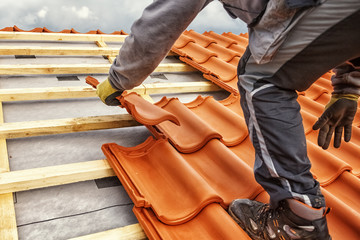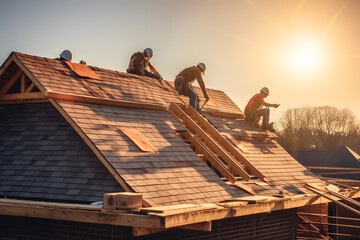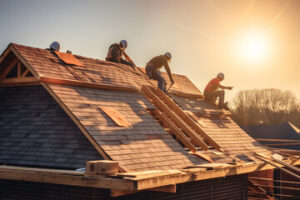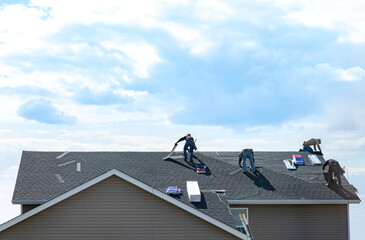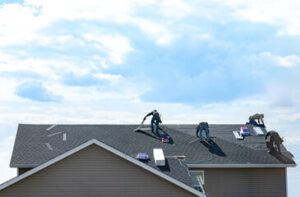Performing regular maintenance can prevent costly repairs down the road. It’s also important for extending the life of roof and wall systems in geographic locations that experience a variety of weather conditions.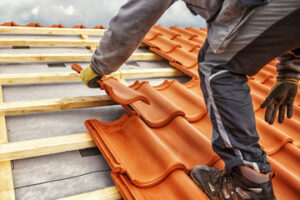
Roofing maintenance includes visual checks of all the areas that are accessible from ground level and from inside the structure. Visit https://www.lakewood-roofing.com/ for more details.
A roof is a barrier between a home and the elements, protecting family members from obvious dangers like weather damage and excess moisture which could lead to mold. However, a roof also protects families from less-obvious hazards like structural problems and energy loss that could lead to skyrocketing electricity bills. The best way to identify these hidden issues is with a thorough inspection.
A professional inspector will first examine the exterior of a roof to ensure proper installation and prevent damage, and then they will assess the interior to find any evidence of water intrusion or leaks. Whether you are a homeowner, home buyer, or building seller, a full inspection of your roof is vital to protect your investment.
An inspection of a roof’s exterior should include cleaning the gutters to prevent blockages, inspecting the flashing around chimneys and vents for signs of leaks, resealing as needed, and checking for any cracks or deterioration in shingle materials. It is also important to check the ventilation system to ensure that it is functioning properly, and to clean out any debris or leaves that may have accumulated over the winter.
In addition, the inspector should look at the gutters and downspouts to make sure that they are not clogged or damaged, and that they are directing water away from the house and into the sewer system as designed. The gutters should be free-flowing to avoid clogging or pooling near the foundation, which can cause serious problems over time.
Finally, the inspector should examine the areas around any roof penetrations, such as satellite dishes and vents. These areas are vulnerable points where water can infiltrate and cause damage to the interior of the home if they are not properly sealed or maintained.
A thorough inspection of a roof should also include checking the attic and ceilings for signs of water intrusion, such as discolored patches on the walls and ceiling, mold or mildew, and sagging drywall. If any of these are present, the roof should be inspected as soon as possible to ensure that there is no structural damage or rot.
Inspect the Interior
Your roof stands between you and the elements, protecting you from both obvious dangers like storms and less-obvious threats like excess moisture that leads to mold. But, it can only do its job if you inspect it regularly and repair any damage before it becomes a serious problem. This is why roof maintenance is so important! In addition to preventing leaks and other structural problems, roof inspection and care also helps save energy and money by keeping the home comfortable.
To conduct an internal inspection, first head into the attic to check for any water damage that may have occurred from a leaky roof. Look for water stains on the ceiling and walls as well as mold or mildew and any other signs of moisture in the structure. If there is any, this is a clear sign that the roof needs to be fixed.
Next, examine the insulation to see if it is damaged or worn. Insufficient or improper insulation can cause heat loss and increase the amount of energy used in the house. It can also cause the heating and cooling system to work harder, which can lead to increased wear and tear on the roof and its components.
Finally, check the seals and flashing around vents, skylights, and chimneys. These areas are susceptible to leaks and should be resealed if needed. Also, make sure that the gutters are clean and free of blockages.
Performing regular roofing maintenance can go a long way in protecting the investment that homeowners have made in their homes. By following these simple steps, you can prevent costly repairs and even extend the life of your roof.
To learn more about roof maintenance, contact a local roofing contractor. They will be able to provide a thorough roof inspection, help you choose the best roofing material, and perform any necessary repairs. They will also be able to recommend a maintenance schedule to keep your roof in top condition. Michael holds a Bachelor of Science in Occupational Safety and Health Management and six years of loss control consulting experience, primarily through property & casualty and excess liability coverages.
Inspect the Flashing
The flashing is a critical part of the roof’s structure. It seals around areas like chimneys, skylights and vent pipes to prevent water leaks. Flashing should be inspected regularly, especially after severe weather conditions and when visible cracks occur.
When flashing is damaged, moisture can enter the home and cause damage to the interior and exterior of the building. It is also possible that the flashing may need to be replaced altogether. Regular inspections and timely repairs will prevent water and moisture intrusion into the home, protecting valuable possessions from damage.
If you plan to perform your own roof inspection, it is important to have the correct tools for safety and effectiveness. A good pair of non-slip shoes, a harness and safety goggles will help you maintain proper footing while inspecting the roof. In addition, a ladder will allow you to reach the safe and accessible areas of the roof. It is also advisable to bring a flashlight, safety rope and a moisture meter for any trouble spots you find on the roof.
Before attempting to repair visible cracks in the flashing, it is necessary to thoroughly clean the area of the crack to remove any dirt or debris that may interfere with the sealing process. Once the crack is cleaned, high-quality roofing sealant can be applied to the crack to provide a watertight barrier that will protect against future leaks.
The most common and dangerous form of flashing damage occurs when pieces become loose or even missing from the roof. This is often caused by extreme weather conditions or improper installation and should be addressed immediately to avoid further damage to the roof and interior of the home.
The flashing on roofs can be made of many different materials, including copper, stainless steel and galvanized metal. Each material has its own unique characteristics, and a roofing professional will be able to recommend the best type of flashing for your roof. Typically, aluminum is preferred because it will not rust and can withstand extreme weather conditions. If your flashing is in need of replacement, a professional will be able to install the new flashing with precision, sealing it tightly and covering it with a protective roof coating.
Inspect the Gutters
Gutters play an important role in protecting a building’s foundation, walls, roof and other surfaces from water damage. Installed along the roof’s edge, gutters help to divert rainwater away from a building’s structure and into downspouts. However, over time, they can become clogged with debris, leading to water overflow and other problems. Regular inspections and cleaning are necessary to prevent these issues from arising.
It’s recommended that homeowners inspect their gutters at least twice a year, and after every severe storm. During these inspections, homeowners should look for any signs that the gutters need to be cleaned or replaced. During this time, it’s also recommended that homeowners clean their gutters and downspouts to remove any dirt, leaves, twigs or other debris that may have accumulated.
During the inspection, homeowners should also look for any rust spots or other signs of corrosion on the gutters and downspouts. They should also take note of any sagging sections or leaks in the gutters and downspouts. If any issues are identified, the homeowner should immediately schedule a professional gutter repair or replacement service.
Aside from the roof and gutters, it’s also a good idea to inspect other areas of the home such as the fascia boards, soffits and chimney flashing. Inspecting these areas for any deterioration or damage can help homeowners avoid costly repairs in the future.
Inspecting the gutters is a task that requires some ladder work, so it’s important to take the proper safety precautions before climbing the ladder. Ensure that the ladder is placed on a stable surface and use stabilizing devices, such as bricks or sandbags, to keep the ladder from tipping over. Also, be sure to enlist the help of a spotter, and never try to reach higher than you’re comfortable with.
When inspecting the gutters, it’s also a great idea to wear rubber gloves to protect yourself from any sharp debris that might be hiding in the gutters. Also, make sure to bring a gutter scoop to help remove any larger debris or obstructions. Finally, it’s a good idea to use a pair of binoculars or a camera with a high magnification to help you get a close-up view of the gutters from the ground.
